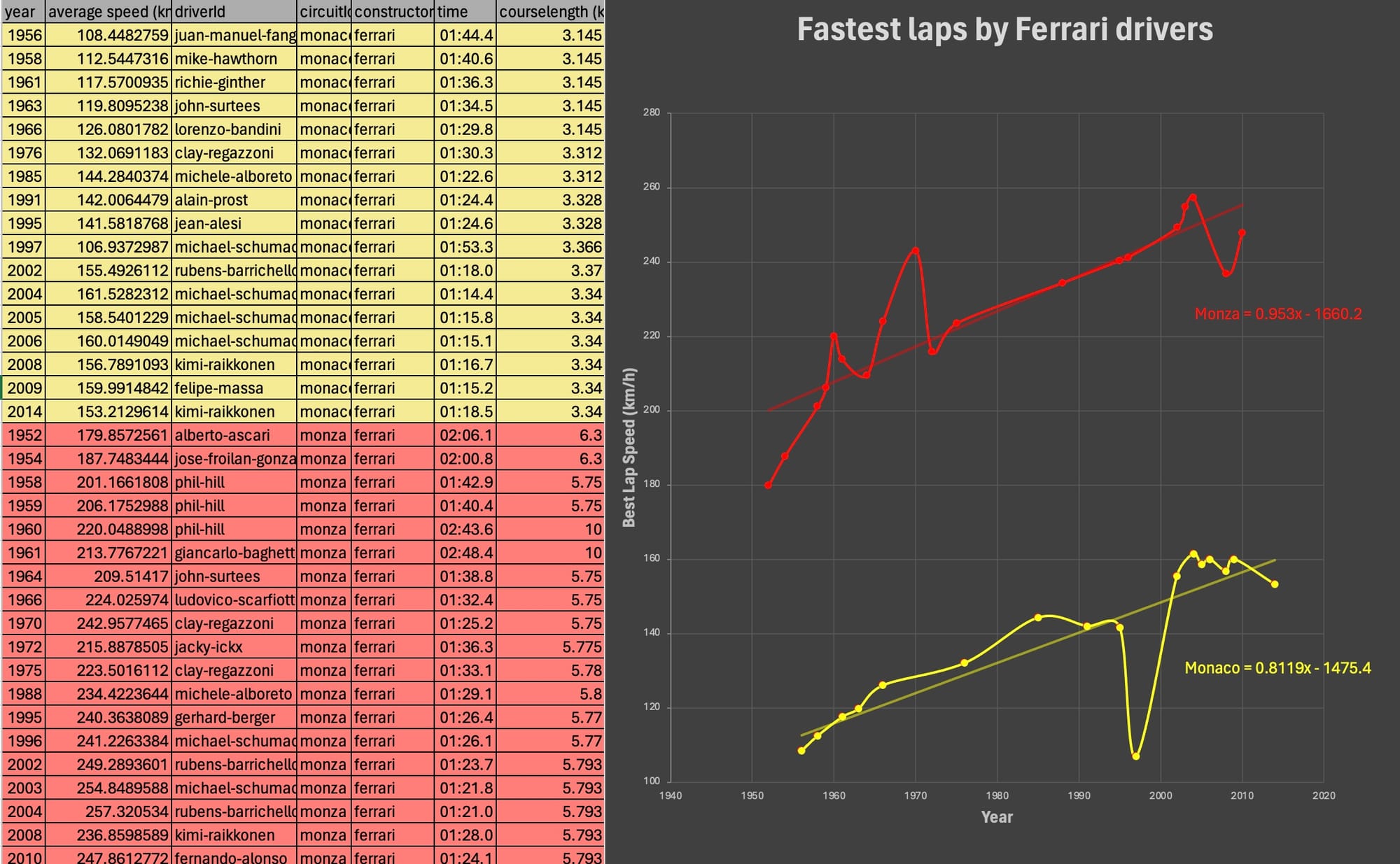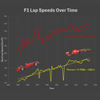Yes. like...a lot faster. Like...if you extrapolate from the current trendline we should be seeing Formula cars that break the sound barrier on the backstretch at Monza somewhere around the year 3284.
I read this writeup on the evolution of the Formula 1 car and it got me wondering how closely the evolution of the hardware would match up with the best lap times recorded year-over-year.
So off into the weeds I went to find the answer!
The cool thing about F1 (or any other competitive sport) is that people have been tracking outcomes for a very long time. Seriously there is sooooo much data. You would think that with this much data it would be really easy to tie speed outcomes to hardware improvements. Right? Well...not quite...

True, hardware evolution is primarily responsible for cars going faster, but there are many other factors that have shortened F1 lap times. For example, rules.
The rulebook governing Formula 1 is a whopping 338 pages long and it has changed pretty much every year since 1950. Each change to the rules governing what comprises a Formula 1 car allows each team to make changes and upgrades. If we want the picture we paint of performance vs. outcomes to be accurate we need to know how rule changes affect the outcomes as well. However...I'm a one man research team. By my calculations, reading each successive change in the rule book and comparing year over year would have taken about a year . Since I don't have that kind of time I've made an assumption:
- This Wikipedia page is a 100% complete synopsis of all of the changes to the rules over time.1
It turned out though, even with this assumption drawing this correlation is a pretty daunting task. I mean think about it....yes, the rules change uniformly. However, each racing team translates those rules into their own breed of racing machine.
The rules are designed to limit the type of hardware used, not to limit the specific performance outcomes.
As an example:
- Max engine displacement: 1500cc
- Max horsepower/torque: Whatever your team can get out of that 1500cc!
- Max speed: Whatever your driver can convince that 1500cc to do!
The level of analytical complexity increases by a factor of nnumber of teams so I abandoned the idea of tracing outcomes back to general rule changes and made 2 more assumptions2:
- The Ferrari F1 team has consistently built the fastest possible car within the limits set by the FIA.
- The Ferrari F1 driver has always driven flawlessly
From the analysis side, this simplifies things greatly. Ferrari has incredible historical detail on their vehicles and combined with the detailed results recording it's possible to correlate hardware changes directly to outcomes. There are anomalies of course (especially in the Monaco data set) but I'm going to set those aside for now. From what I can tell, the three major ones are most likely a result of track conditions3.
OK. Parameters are set, here's the approach
I'm going to create a database of Ferrari performance data and race results so we can correlate hardware advancement to race outcomes.

OK hold up. There is data on everything from fuel feed to clutch type and this is going to take forever. I'm going to have to make another assumption that I know is wrong but otherwise this will never get finished:
- The most important factor in determining how fast an F1 car gets around the track is horsepower4

OK seriously?! This dataset is still insane and it doesn't even factor in the driver's performance. Here's what we're gonna do. We're going to look at Monza and Monaco fast laps. In years where that lap time was set by a Ferrari driver we're going to create a table that shows specific data on the car the driver was using.
Here!

OK. It took a few hours, but we've got a manageable data set we can add our hardware specs on to. Monza is a faster track, so I'm planning to drop the Monaco dataset to simplify things further and illustrate the point more clearly. Here is the resulting data including the relevant (as established above) hardware details.

Quick sidebar...the RPM and HP increase over the years kinda smacked me right in the face and I got distracted. Seriously...look at this

On average, every year since 1952 max power output has increased by 11 hp and the rotational speed of the engine at that output range has gone up by 200 RPM!
The RPM number is especially impressive to me. Max RPM is directly correlated to strength of materials, engineering tolerances, and other manufacturing advances. The RPMs have increased linearly, but since rotational inertia is a function of the square of rotational speed the loads these engines are seeing have actually increased exponentially and so have the manufacturing advances required to support them!
How does that impact outcomes?
Like this:

While this is kind of interesting and illustrates a general trend, we've got to normalize this before it's going to make any sense. What we need to do if we're going to get the relationship between hardware improvement and speed improvement is normalize all of the data. Time to convert everything to a percentage improvement since the beginning of F1 and then plot lap time performance increase (speed in km/h) as a function of engine performance increase (power in hp) over time. Here's what that looks like.

This is a little deceiving, but pretty evident that something interesting happened in the late 50s and early 60s. Horsepower remained steady at about 275 during that time period so engine advancements are not the reason behind this...what happened is this:

The aerodynamics and CG of the vehicles evolved rapidly as the rules evolved. Drag became much less of an issue and cornering speed increased significantly in that time period which caused a huge initial spike in speed to power ratio
So why does our ratio drop off so sharply after the initial jump?
Because engines started getting stupid powerful. In 1961 Ferrari was running on 190 HP, by 1966 that number was up to 360! Aerodynamic gains were a huge advantage but the effect on the speed/power ratio was brought back into balance by a massive increase in raw power.
There is a constant evolution of hardware happening that is counterbalanced by rules designed to maintain the core "feel" of the sport and driver safety. This chart shows the initial growing pains really clearly, but it also a gradual convergence on a typical speed : power ratio. This seems to approach a steady state at around .3 km/h per horsepower.
This means that the thousand years from now vehicle doing Mach 1 in the Monza backstretch is going to need about 4141 hp.
Should be an interesting looking machine!
Footnotes:
- On large topics with a broad fan base I have found Wikipedia to be incredibly reliable. Never underestimate the accuracy produced by groups of pedantic nerds trying to prove they're smarter than each other.
- This assumption will probably make F1 fans very angry but I don't care because Ferrari also happens to have a historical infographic of the evolution of their cars that I am 100% using in this article because it's rad.
- I don't know this for sure, but if you are inspired to research it further please let me know what you find. I'll append it to the article with a credit to you.
- This assumption makes me hurt on the inside because it's a huge oversimplification but that's just the way this is gonna have to be.


